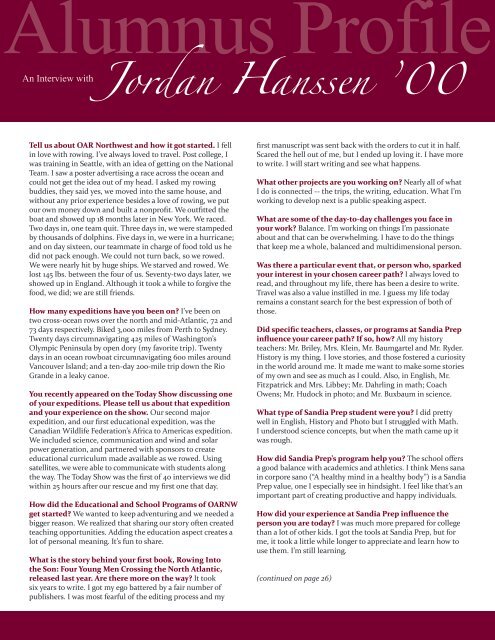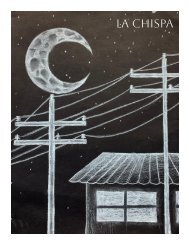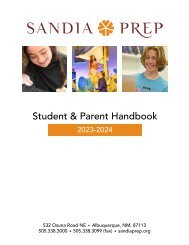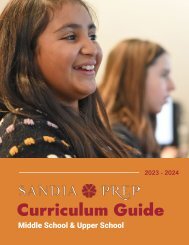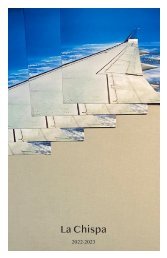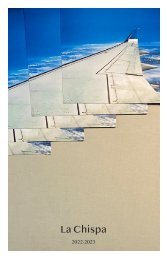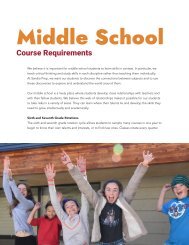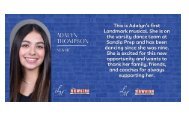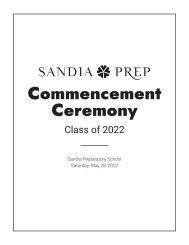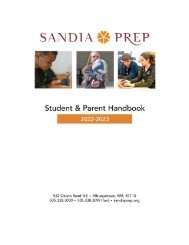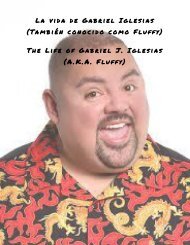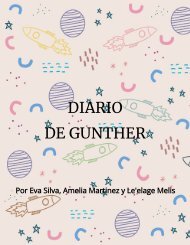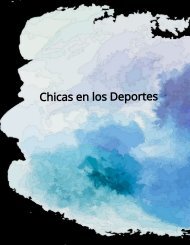You also want an ePaper? Increase the reach of your titles
YUMPU automatically turns print PDFs into web optimized ePapers that Google loves.
An Interview with<br />
Alumnus Profile<br />
Jordan Hanssen ’00<br />
Tell us about OAR Northwest and how it got started. I fell<br />
in love with rowing. I’ve always loved to travel. Post college, I<br />
was training in Seattle, with an idea of getting on the National<br />
Team. I saw a poster advertising a race across the ocean and<br />
could not get the idea out of my head. I asked my rowing<br />
buddies, they said yes, we moved into the same house, and<br />
without any prior experience besides a love of rowing, we put<br />
our own money down and built a nonprofit. We outfitted the<br />
boat and showed up 18 months later in New York. We raced.<br />
Two days in, one team quit. Three days in, we were stampeded<br />
by thousands of dolphins. Five days in, we were in a hurricane;<br />
and on day sixteen, our teammate in charge of food told us he<br />
did not pack enough. We could not turn back, so we rowed.<br />
We were nearly hit by huge ships. We starved and rowed. We<br />
lost 145 lbs. between the four of us. Seventy-two days later, we<br />
showed up in England. Although it took a while to forgive the<br />
food, we did; we are still friends.<br />
How many expeditions have you been on? I’ve been on<br />
two cross-ocean rows over the north and mid-Atlantic, 72 and<br />
73 days respectively. Biked 3,000 miles from Perth to Sydney.<br />
Twenty days circumnavigating 425 miles of Washington’s<br />
Olympic Peninsula by open dory (my favorite trip). Twenty<br />
days in an ocean rowboat circumnavigating 600 miles around<br />
Vancouver Island; and a ten-day 200-mile trip down the Rio<br />
Grande in a leaky canoe.<br />
You recently appeared on the Today Show discussing one<br />
of your expeditions. Please tell us about that expedition<br />
and your experience on the show. Our second major<br />
expedition, and our first educational expedition, was the<br />
Canadian Wildlife Federation’s Africa to Americas expedition.<br />
We included science, communication and wind and solar<br />
power generation, and partnered with sponsors to create<br />
educational curriculum made available as we rowed. Using<br />
satellites, we were able to communicate with students along<br />
the way. The Today Show was the first of 40 interviews we did<br />
within 25 hours after our rescue and my first one that day.<br />
How did the Educational and School Programs of OARNW<br />
get started? We wanted to keep adventuring and we needed a<br />
bigger reason. We realized that sharing our story often created<br />
teaching opportunities. Adding the education aspect creates a<br />
lot of personal meaning. It’s fun to share.<br />
What is the story behind your first book, Rowing Into<br />
the Son: Four Young Men Crossing the North Atlantic,<br />
released last year. Are there more on the way? It took<br />
six years to write. I got my ego battered by a fair number of<br />
publishers. I was most fearful of the editing process and my<br />
first manuscript was sent back with the orders to cut it in half.<br />
Scared the hell out of me, but I ended up loving it. I have more<br />
to write. I will start writing and see what happens.<br />
What other projects are you working on? Nearly all of what<br />
I do is connected -- the trips, the writing, education. What I’m<br />
working to develop next is a public speaking aspect.<br />
What are some of the day-to-day challenges you face in<br />
your work? Balance. I’m working on things I’m passionate<br />
about and that can be overwhelming. I have to do the things<br />
that keep me a whole, balanced and multidimensional person.<br />
Was there a particular event that, or person who, sparked<br />
your interest in your chosen career path? I always loved to<br />
read, and throughout my life, there has been a desire to write.<br />
Travel was also a value instilled in me. I guess my life today<br />
remains a constant search for the best expression of both of<br />
those.<br />
Did specific teachers, classes, or programs at Sandia Prep<br />
influence your career path? If so, how? All my history<br />
teachers: Mr. Briley, Mrs. Klein, Mr. Baumgartel and Mr. Ryder.<br />
History is my thing. I love stories, and those fostered a curiosity<br />
in the world around me. It made me want to make some stories<br />
of my own and see as much as I could. Also, in English, Mr.<br />
Fitzpatrick and Mrs. Libbey; Mr. Dahrling in math; Coach<br />
Owens; Mr. Hudock in photo; and Mr. Buxbaum in science.<br />
What type of Sandia Prep student were you? I did pretty<br />
well in English, History and Photo but I struggled with Math.<br />
I understood science concepts, but when the math came up it<br />
was rough.<br />
How did Sandia Prep’s program help you? The school offers<br />
a good balance with academics and athletics. I think Mens sana<br />
in corpore sano (“A healthy mind in a healthy body”) is a Sandia<br />
Prep value, one I especially see in hindsight. I feel like that’s an<br />
important part of creating productive and happy individuals.<br />
How did your experience at Sandia Prep influence the<br />
person you are today? I was much more prepared for college<br />
than a lot of other kids. I got the tools at Sandia Prep, but for<br />
me, it took a little while longer to appreciate and learn how to<br />
use them. I’m still learning.<br />
(continued on page 26)<br />
11 <strong>532</strong> • <strong>Fall</strong> 2013


